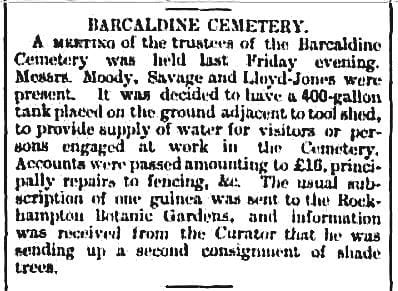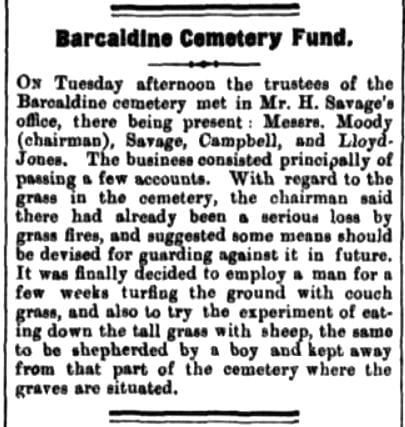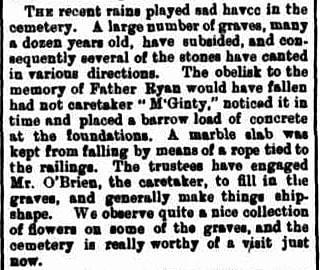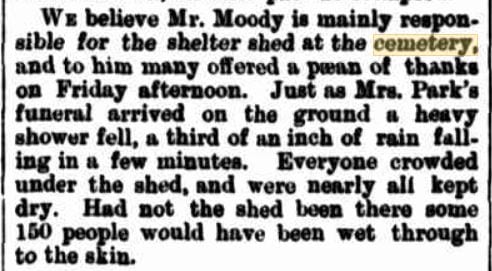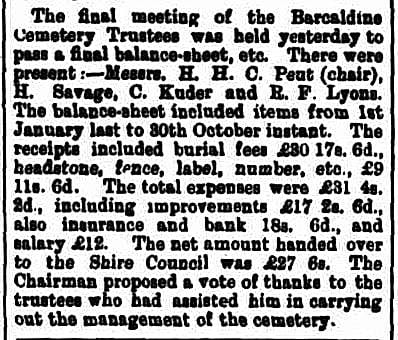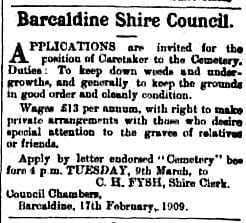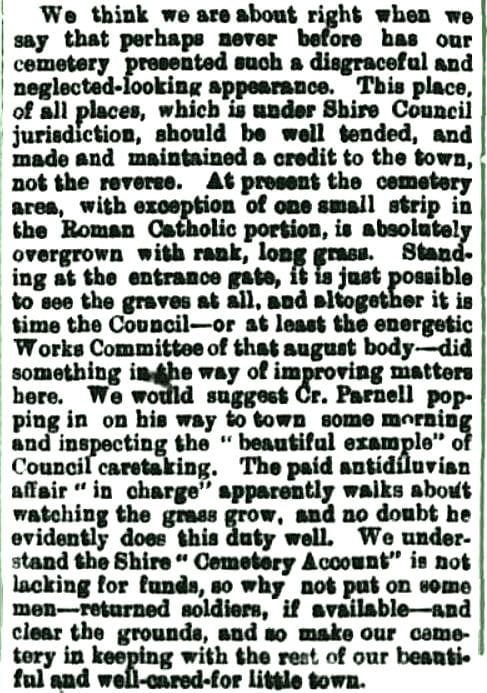OLD BURIAL GROUND
The first cemetery in Barcaldine was referred to as ‘The Old Burial Ground’. It appears to have been a plot of ground in the area that became the recreation ground, now the Showgrounds.
The first Pastoral, Agricultural and Horticultural Society Show (The Show) was held in July 1914. The recreation reserve was leased from Barcaldine Shire Council, and it was reported that an enlarged area was fenced and headstones from the first cemetery were removed from the new enclosure (Source: Between the Bougainvilleas, 2004). The old burial ground appears to have had its own fence prior to that.
The exact location of the old burial site is now unclear. Some say it was on the edge of where the new racecourse is now situated on the northern side of the Showgrounds. That makes some sense as the location of the old burial ground quickly became a problem because of its proximity to Lagoon Creek. The article below from the Western Champion newspaper tells us why.
The present site is quite unsuitable for many reasons. It is close to the sheep and cattle yards and on the slope of Lagoon Creek, which drains the area. The sand is not deep, and for months after rain graves cannot be dug without speedily being filled with water. There is no necessity to explain how dangerous this is for the public health, more especially when the germs of typhoid are interred with the dead, as the water in Lagoon Creek is drunk by dairy cattle, which supply the milk consumed by the town. The surveyed cemetery is situated about half a mile along the railway line, where the soil is drier, and the depth of sand greater. The channel of the creek is also much further away. ...
... we learn from Messrs. Meacham & Leyland, undertakers, that interments have taken place there [in the old cemetery] during the last three years. The mounds marking the majority of the graves have been obliterated altogether by the tramping of cattle and sheep. The soil at a depth of almost five feet is saturated with water, which drains into Lagoon Creek. When the Government surveyed the site of the new cemetery, eighteen months ago, they gave positive instructions to Mr. Warraker to survey it at least half-a-mile from the present burial ground. During the past week instructions have been given for no further burials to take place in the present cemetery. As three deaths have occurred since this order was given the remains have been interred in the new cemetery....Western Champion, 21 May 1889 Tweet
There is some discrepancy about whether the bodies and headstones of those buried at the old site were removed to the new cemetery once burials started there.
One newspaper report mentioned that the remains of all those buried in the original cemetery were transferred to the new.
Another report in the Western Champion of 1913 indicated that some of the headstones were still at the old burial ground.
..... We found upon visiting the place the ground was as clear of scrub and weeds as the recreation reserve itself. The surrounding fence was in good order. In the small enclosure a gaunt dead gum reared its bare arms, typical of the dead beneath it, while at the extreme end was one other tree. The graves were all levelled, and there were no traces of vases, shells or wreaths. The only things to remind one of a cemetery were two stones, remains of a few wooden fences, and a couple of good iron railings. The graves had apparently been placed in three rows. Ont he western side was a stone with the top broken off it bearing a decipherable inscription, "Arthur Charles, born 1st Feb. 1886, died 9th Aug 1887": this has a substantial iron railing. Then come four broken wooden fences, with railings all gone - as are all the others - one having a decayed gothic-shaped board on which some years ago had been an inscription, and to finish the row is one post, doubtless sole representative of a fence. In the centre row is an iron railing, at the head of which is a broken stone. As far as can be made out the inscription reads:- "Robert Richard Nicholson, 15th Aug. 1887, aged 15 months; also his brother .... died 11th Dec. 1888, aged [looks like] 26". The stone had been broken in half and repaired. Two wooden frames complete the centre portion of this peaceful looking little God's acre. On the eastern sides are six wooden frames, and one substantial iron railing. On the northern side, outside the enclosure, is a frame of bush timber, very substantially built. That completes the whole of the old cemetery. What is to be done with it is a matter for the [Show] Society Committee to decide. There certainly could be little traffic over the spot as it will adjoin a possible cricket pitch or running track, and the fence could be removed, the fences and stones taken to the present cemetery and the ground allowed to remain as it is without giving offence to anybody
Western Champion, 23 August 1913
The details of those buried in the first cemetery do not appear to have been entered into a register so the report above offers a useful if small clue to some of those who were buried there.
There is also a reference to a man being employed to ‘do up the old cemetery site’ six years after the new cemetery came on line (Western Champion, 17 September 1895).
NEW CEMETERY
The move to the new cemetery appears to have occurred in 1889 although the site was not surveyed by Mr Desgrand (who surveyed the township of Barcaldine in 1885) until 1893. The Plan is signed and dated by V Desgrand, Licensed Surveyor, on 12 June 1893.
It also appears that the first burials in the cemetery occurred before the site was surveyed by Desgrand. The earliest graves have been marked on the surveyed plan – after the event – as they were found by the surveyor.
They are therefore not entirely within the grid then laid out by Desgrand. A news item referred to the survey plan as ‘showing where burials had [already] taken place’.
The 21 May 1889 newspaper report (above) mentioned a survey for the new cemetery – 18 months prior to May 1889 so probably sometime early in 1888. That would have been shortly after the settlement of the township.
The ‘official’ / final survey was however conducted by Vincent Desgrand and was not signed off until 1893 – 7 years later.
Burials did cease at the old burial site in 1889 because the first burial recorded in the Register for the new cemetery was 14 May 1889.
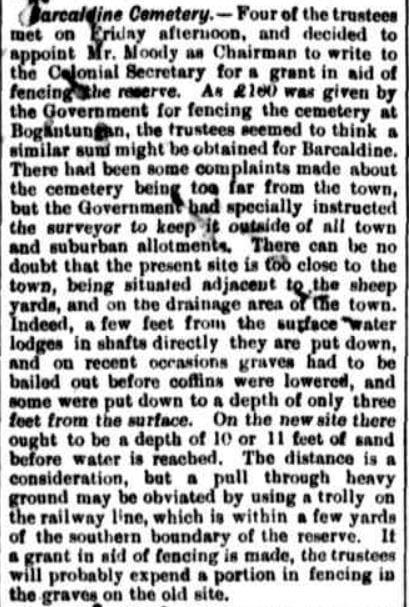
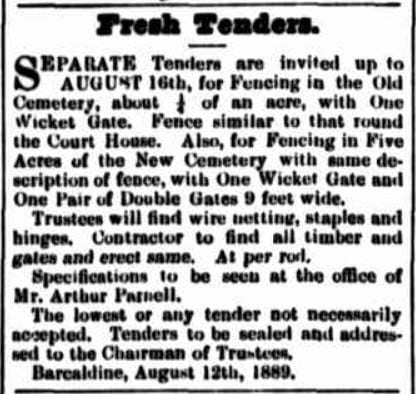
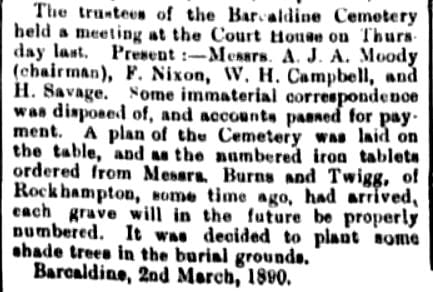


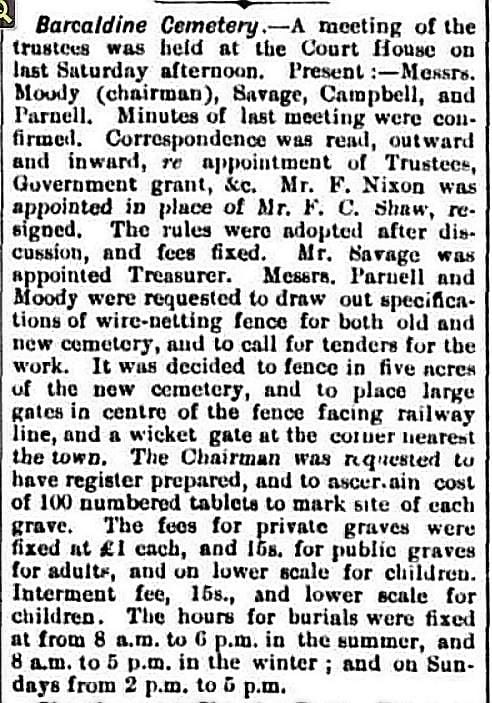
It appears that the remains of those in the old burial ground had still not been removed to the new cemetery by 1913.


A plan of the cemetery was framed in cedar, and together with the various indices showing the names of those buried, was to be made available for reference upon application.
The plan now resides in the Barcaldine Regional Council strongroom.

ROMAN CATHOLIC SECTION
In August 1897, the cemetery trustees approved a separate section for Catholics. Until then, there was no distinction between Protestants and Catholic areas on the site. The plan drawn up by Mr Desgrande in 1893 did however include a Catholic section so it must have been a few years before burials in separate religious sections was implemented. By then the number of burials had almost reached 100 , and new iron tablets were ordered for the next 100.
Some of the original iron tablets are still in evidence in the cemetery today although they may not be attached to the right gravesite.
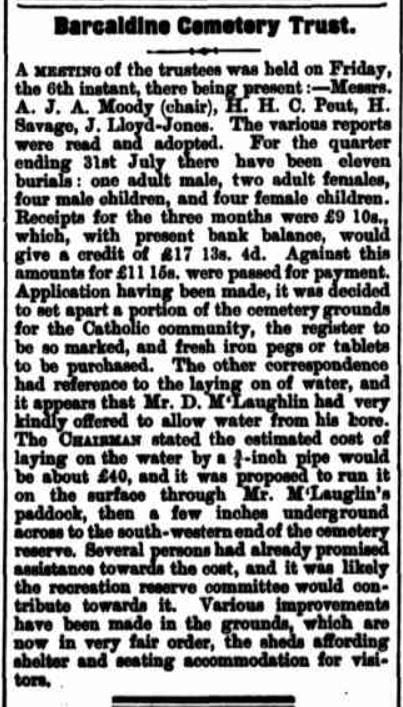
UNDERTAKERS AND HEARSES
The firm of Meacham & Leyland had the role of undertakers for the town from the beginning.
They also designed and built the hearses. On at least one occasion, Meacham & Leyland built a hearse for Longreach.
They also built a child’s hearse. That would have been well used as, in the years from 1889 to 1899, 47% of all burials were children under one year of age.
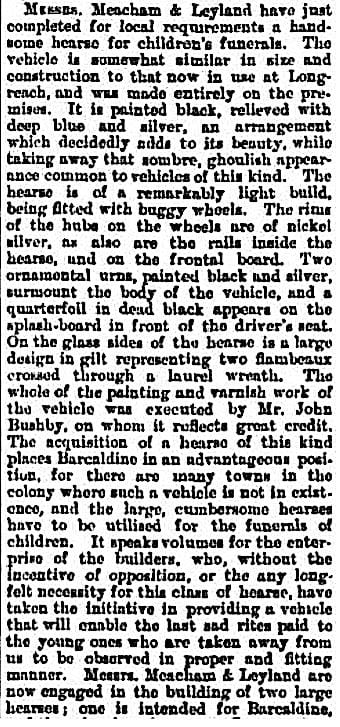
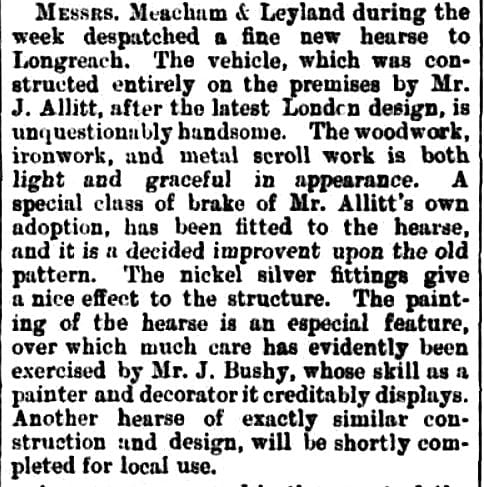
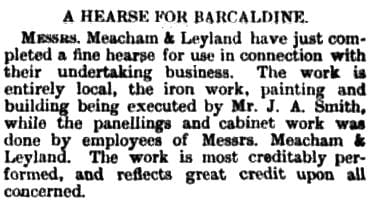

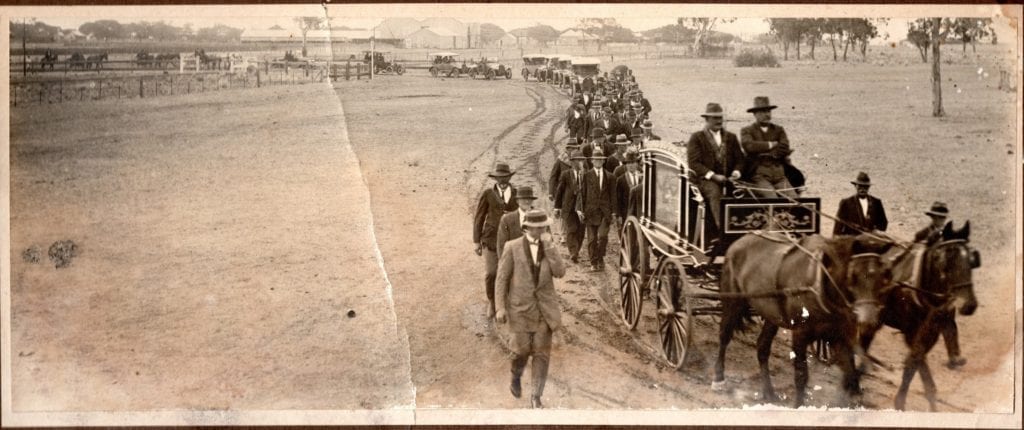
Trustees, Caretakers, Maintenance
The cemetery was administered by trustees from 1899 to 1908. After that, the Barcaldine Shire Council took on responsibility for the grounds.
Maintenance of the new cemetery site was an ongoing issue – fencing, grass, overgrowth, water, shade and shelter were all reported as issues.
Attempts were made on many occasions to beautify the grounds, without success. Severe summers were often to blame, and grass fires destroyed the vegetation. Or there was too much – ladies visiting the site at times had to contend with grass seeds and bindyeye burrs attaching to their clothing because of the unkempt state of the grounds.
The trustees tried turfing the ground with couch grass. They tried to keep the tall grass down by allowing sheep to eat the grass and employing a boy shepherd to keep the sheep away from the part where the graves were situated.
On one occasion, the newspaper suggested Cr Parnell should pop in one morning to ‘inspect the “beautiful example” of council caretaking. Apparently ‘the paid antidiluvian’ in charge walked about ‘watching the grass grow’ and ‘did this duty well’.
A couple of unsuccessful attempts were made to grow trees on site – although some seemed to survive against the odds. It may have been that unsuitable trees were sourced from the Botanic Gardens in Rockhampton.
In May 1896, some graves subsided during heavy rain.
Another issue concerned the number of campers on the site. The newspaper pointed out:
the impropriety of allowing persons to camp on the road and crowd lands in proximity to the cemetery. At the present time there are at least a dozen old tents of calico and bagging erected, some on the unfenced portion of the cemetery reserve and some right upon the roadway. The fencing is used as a clothes horse for the garments of some of the people, while others utilise it as a drying line for the " wash." Apart from all sanitary protection for the living the cemetery trustees have to consider the sanctity of the spot where the remains of our relatives and friends are buried and they should make immediate application to the proper authorities to insist upon all dwelling places being removed from the roadway, reserve and crown lands in the immediate vicinity of the burial ground. On the other side of the railway line there are several acres of suburban lands upon which those employed in the meat works can obtain per mission to build their residences.
Western Champion, 31 January 1893
